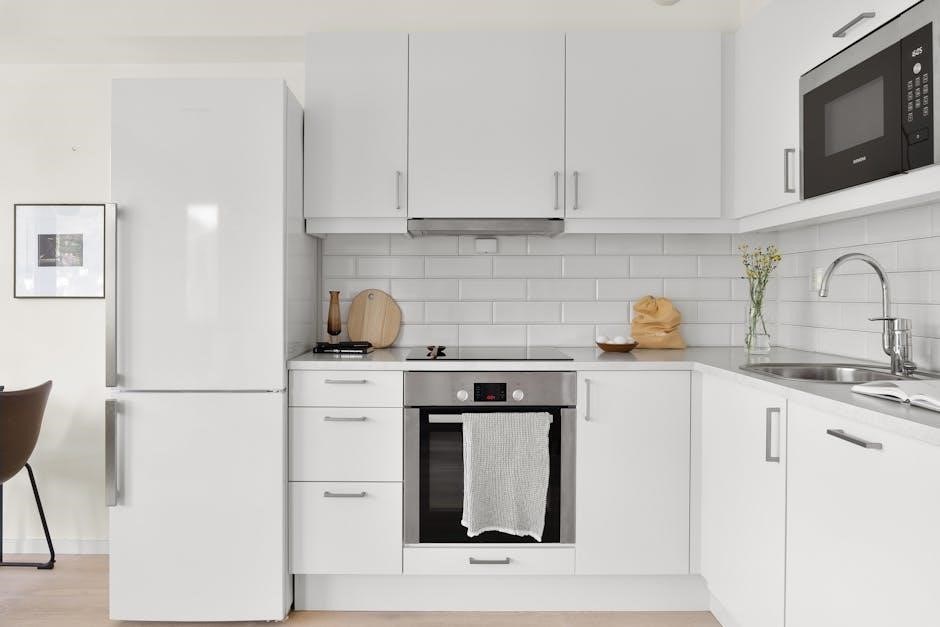Welcome to our guide on cooking Stouffer Lasagna! This classic dish is a staple for quick, delicious meals. Proper cooking techniques ensure food safety, quality, and flavor. Whether using the microwave or oven, following instructions closely guarantees a perfectly cooked lasagna. Learn how to achieve even heating, avoid undercooking, and get that golden-brown crust.
1.1 Brief Overview of Stouffer Lasagna
Stouffer Lasagna is a beloved, convenient meal solution offering layers of pasta, rich meat sauce, and creamy cheese. Perfect for quick dinners, it’s designed for microwave or oven cooking. With high-quality ingredients and consistent taste, it’s a favorite for many. Ideal for busy households, it delivers a homemade experience without the hassle. Available in various sizes, it’s great for families or individuals. Follow package instructions for best results and enjoy a perfectly cooked, satisfying meal every time.
1.2 Importance of Proper Cooking Techniques
Proper cooking techniques are crucial for achieving a delicious, safe, and satisfying meal with Stouffer Lasagna. Undercooking can lead to a cold center and tough texture, while overcooking may result in dry, mushy layers. Following the recommended instructions ensures even heating, preventing foodborne illness and maintaining flavor. Cooking methods differ between microwave and oven; the microwave offers quick results but requires careful monitoring, while the oven provides a golden-brown crust and even heating. Adhering to guidelines ensures the lasagna is cooked to perfection, delivering a hearty, satisfying dish every time.
Safety Tips
Always handle frozen lasagna safely, ensuring it’s stored at 0°F (-18°C) or below. Never consume undercooked or raw lasagna, as it’s not ready to eat.
2.1 Handling Frozen Lasagna
Stouffer Lasagna should be stored at 0°F (-18°C) or below to maintain quality. Always handle the frozen lasagna with clean hands or utensils to prevent contamination. If thawing is needed, place the lasagna in the refrigerator at 40°F (4°C) or below for 24-48 hours. Avoid thawing at room temperature to prevent bacterial growth. Never refreeze thawed lasagna, as this can affect texture and safety. When cooking from frozen, ensure the lasagna is placed in a microwave-safe or oven-safe dish to prevent damage. Always follow the package instructions for safe handling and cooking practices to ensure a delicious and safe meal.
2.2 Essential Safety Tips
Always handle frozen lasagna safely to avoid accidents. Use oven mitts when removing hot dishes from the oven or microwave. Ensure the cooking area is clear of flammable materials. Avoid overheating, as it can cause burns or fires. Use a microwave-safe dish to prevent shattering. Never leave cooking unattended, especially when using the microwave. Keep children away from hot surfaces and appliances. Allow the lasagna to cool slightly before serving to prevent burns. Check the internal temperature to ensure it reaches a safe minimum of 165°F (74°C). Always follow the package instructions for specific safety guidelines. Proper handling and cooking techniques ensure a safe and enjoyable meal.

Storage Instructions
Store Stouffer Lasagna in the freezer at 0°F (-18°C) to maintain quality. Keep the dish airtight and avoid cross-contamination. Thaw safely in the refrigerator before cooking.
3.1 Freezer Storage Tips
To maintain the quality and safety of Stouffer Lasagna, store it in the freezer at 0°F (-18°C). Ensure the lasagna is in an airtight, moisture-proof package or wrapped tightly in plastic wrap or aluminum foil to prevent freezer burn. Place the lasagna on a flat surface in the freezer to avoid uneven freezing. Keep it away from strong-smelling foods, as odors can transfer. For optimal freshness, use within 3–4 months. When ready to cook, thaw the lasagna in the refrigerator overnight before cooking. Do not refreeze after thawing, as this can affect texture and safety. Always label the storage date to track how long it has been frozen.
3.2 Shelf Life Information
Stouffer Lasagna has a shelf life of up to 3–4 months when stored properly in the freezer at 0°F (-18°C). Always check the “Best If Used By” date on the packaging for freshness. If thawed, refrigerate and use within 3–5 days. Cooked lasagna should be refrigerated and consumed within 3 days. To maintain quality, store it in its original packaging or transfer to an airtight container. Freezing is the best way to preserve lasagna, while refrigeration is ideal for short-term storage. For safety, discard if you notice any signs of spoilage, such as an off smell or mold. Always follow proper food safety guidelines to ensure a tasty and safe meal.

Microwave Cooking Instructions
Cook Stouffer Lasagna in the microwave by placing it in the center, uncovered, at 100% power. Cook on high for 3–4 minutes per serving, then let stand 1–2 minutes to ensure even heating and safety.
4.1 Step-by-Step Microwave Cooking Guide
Place the lasagna tray in the microwave, ensuring it’s centered and uncovered.
Cook on high power for 3–4 minutes per serving. Adjust based on your microwave’s wattage.
After cooking, let it stand for 1–2 minutes to allow even heating.
Carefully remove the hot tray and serve. Always use oven mitts to handle the tray.
This method ensures quick and even cooking while maintaining flavor and texture. For best results, follow the package instructions and adjust cooking time as needed.
4.2 Adjusting Cooking Time Based on Wattage
Cooking time in the microwave varies depending on its wattage. Higher wattage microwaves cook faster, while lower wattage requires more time. For example, at 1100 watts, cook for 3–4 minutes per serving, while at 700 watts, increase the time to 5–6 minutes. Always check your microwave’s wattage, usually found in the manual or on the appliance. Adjust the cooking time accordingly to ensure even heating and prevent overcooking. If unsure, start with the lower range and check the lasagna’s progress. Let it stand for 1–2 minutes after cooking to allow even heat distribution. This ensures a perfectly cooked meal tailored to your microwave’s power level.
4.3 Tips for Even Cooking in the Microwave
To ensure even cooking in the microwave, rotate the lasagna tray halfway through the cooking time. This helps distribute heat uniformly and prevents hot spots. Use a microwave-safe container if necessary, and avoid overcrowding the tray. Covering the dish with a microwave-safe lid or plastic wrap can help retain moisture and promote even heating. If your microwave has a turntable, ensure it rotates smoothly. For thawed lasagna, reduce cooking time slightly to avoid overcooking. Always check the lasagna’s internal temperature, ideally 165°F, to confirm doneness. Let it stand for 1–2 minutes after cooking to allow heat to distribute evenly. These tips ensure a perfectly cooked, consistent result every time.

Oven Cooking Instructions
Preheat your oven to 400°F. Remove the lid and bend it slightly to allow steam to escape. Place the lasagna on a baking sheet and cook for 50 minutes. Let it stand for 5 minutes before serving for the best results.
5.1 Step-by-Step Oven Cooking Guide
Preheat your oven to 400°F. Remove the lasagna tray from the box and place it on a baking sheet. Take off the lid and bend it slightly in the middle along the short edges to create a ridge for even cooking. This helps steam escape and prevents sogginess. Place the tray on the center rack of the oven and cook for 50 minutes. For a crisper crust, uncover the lasagna for the last 10 minutes of cooking. Let it stand for 5 minutes before serving. Ensure the internal temperature reaches 165°F for food safety. This method ensures a golden-brown, perfectly cooked lasagna every time.
5.2 Achieving the Perfect Crust in the Oven
To achieve a perfect crust, preheat your oven to 400°F. Remove the lasagna from the box and place it on a baking sheet. Bend the lid slightly in the middle to allow steam to escape, ensuring even cooking. Cook for 50 minutes, then uncover for the last 10 minutes to crisp the top. For an extra-golden crust, increase the oven temperature to broil for the final 2-3 minutes. Avoid overbrowning by monitoring closely. Let the lasagna rest for 5 minutes before serving to retain moisture and ensure a firm texture. This method guarantees a crispy, golden-brown crust while maintaining a tender, flavorful interior.
5.3 Tips for Optimal Oven Cooking Results
For the best oven-cooked lasagna, preheat to 400°F and remove the lid. Bend the lid slightly to allow steam to escape, ensuring even cooking. Cook for 50 minutes, then uncover for 10 minutes to crisp the top. Check for doneness by ensuring the sauce bubbles gently and the cheese is golden. Let the lasagna rest for 5 minutes before serving to allow flavors to meld and the structure to set. This method ensures a crispy crust and a tender, flavorful interior. Avoid overheating to prevent drying out the layers. These tips guarantee a perfectly cooked, restaurant-quality Stouffer Lasagna every time.

Alternative Cooking Methods
Explore alternative methods like slow cooker and thawing for Stouffer Lasagna. Slow cooker offers a hands-off approach, while thawing ensures even cooking in less time.
6.1 Slow Cooker Instructions

Cooking Stouffer Lasagna in a slow cooker is a convenient hands-off method. Place the lasagna tray directly into the slow cooker without venting. Set the cooker to High and cook for 4 hours undisturbed. This method ensures even heating and prevents drying out. Avoid lifting the lid during cooking to maintain moisture. For best results, let the lasagna rest for 10-15 minutes before serving. This approach is ideal for busy days, offering a perfectly cooked meal with minimal effort. The slow cooker method guarantees tender layers and a flavorful dish every time. It’s a great alternative to oven or microwave cooking, providing consistent results without constant supervision. Simply set and forget for a delicious, stress-free meal.
6.2 Thawing Methods Before Cooking
Thawing Stouffer Lasagna before cooking can enhance the cooking process, though it’s not always necessary. For safe thawing, place the lasagna in the refrigerator overnight (6-8 hours). Alternatively, submerge the sealed lasagna in cold water, changing the water every 30 minutes to prevent bacterial growth. For quicker thawing, use the microwave’s defrost function, checking every 2-3 minutes to avoid uneven thawing. Once thawed, cook immediately to ensure food safety. Proper thawing helps achieve even cooking and prevents undercooked or overcooked sections. Note that thawing times vary depending on the method and size of the lasagna. Always follow safe food handling practices to maintain quality and prevent contamination. This step ensures your lasagna cooks evenly, whether in the oven, microwave, or slow cooker.

Troubleshooting Common Issues
Common issues include overcooking, undercooking, or uneven heating. Adjust cooking times, check internal temperature, and ensure proper thawing. Prevent crust burns by covering edges if needed.
7.1 Avoiding Overcooking
Overcooking can lead to dry, burnt edges and an unappealing texture. To avoid this, monitor the lasagna closely during the final minutes of cooking. In the microwave, check every 30 seconds after the halfway mark. In the oven, cover the edges with foil if they start to brown too quickly. Use a food thermometer to ensure the internal temperature reaches 165°F without exceeding it. Avoid overheating, especially when reheating leftovers. Adjust cooking times based on portion size and wattage for microwaves. Properly thawing the lasagna before cooking also helps prevent overcooking, ensuring even heating throughout.
7.2 Preventing Undercooking
Undercooking can result in a cold center and an uncooked texture. To prevent this, ensure the lasagna is heated evenly. In the microwave, follow the recommended cooking time based on wattage and check for a hot, steaming center. For ovens, use the middle rack and avoid overcrowding. Cover the dish initially to trap heat, then remove the cover to allow the top to brown. Always verify internal temperature, aiming for 165°F. Avoid thawing at room temperature; instead, thaw in the fridge or cook frozen with adjusted times. Properly following package instructions ensures thorough cooking and food safety. Consistent heat distribution is key to preventing undercooked sections.
7.3 Common Mistakes and Solutions
One common mistake when cooking Stouffer Lasagna is improper defrosting, leading to uneven cooking. Always thaw in the fridge or cook frozen as instructed. Another error is removing the cover too early, which can prevent the crust from forming properly. Avoid overcrowding the oven or microwave, as this disrupts air circulation. Ensure the lasagna is placed on the middle rack for even heating. If using the microwave, stir or rotate midway to prevent hot spots. For oven cooking, preheating to the correct temperature is crucial. Finally, letting the lasagna rest after cooking allows the layers to set, ensuring a cleaner slice. Addressing these issues guarantees a perfectly cooked meal every time.
Nutritional Information
Stouffer Lasagna serves up approximately 300-350 calories per serving, with 35-40g of carbs, 15-20g of protein, and 10-15g of fat. It’s a satisfying, nutrient-rich meal option.
8.1 Caloric Content
A single serving of Stouffer Lasagna typically contains between 300-350 calories, depending on the specific variety and serving size. This makes it a moderately calorie-dense meal option. The caloric content is primarily derived from carbohydrates, proteins, and fats, which are balanced to provide sustained energy. Cooking methods, whether microwave or oven, do not significantly alter the caloric intake. However, portion control is essential for maintaining a healthy diet. The meal is designed to be satisfying while keeping calorie counts reasonable for a hearty, comforting dish. Always check the packaging for precise nutritional details, as variations may exist across different product lines.
8.2 Macro and Micro Nutrient Breakdown
A single serving of Stouffer Lasagna provides a balanced mix of macronutrients, including carbohydrates, proteins, and fats. Carbohydrates make up the majority, sourced from pasta and tomato-based sauce, while proteins are primarily from beef and cheese. Fats are present in moderate amounts, largely from cheese and meat. Micronutrients include essential vitamins like B vitamins from the pasta and vitamin A from tomatoes, along with minerals such as calcium and iron. Sodium content is notable due to the sauce and cheese. This nutrient profile makes Stouffer Lasagna a convenient, nutritionally adequate meal option when consumed as part of a balanced diet. Always refer to the packaging for precise nutritional details, as values may vary slightly by product.
Taste Variations
Stouffer Lasagna is a classic dish loved for its rich flavor. Enhance your meal by adding extra cheese for creaminess or incorporating vegetables for freshness and texture.
9.1 Adding Extra Cheese
For an extra burst of flavor, consider adding extra cheese to your Stouffer Lasagna. Sprinkle shredded mozzarella or parmesan on top before cooking for a creamier texture. In the microwave, add cheese halfway through cooking to ensure even melting. In the oven, layer additional cheese between lasagna sheets or on top for a golden, bubbly crust. Experiment with blends like ricotta or provolone for unique taste variations. For the best results, mix cheeses before adding to avoid clumping. This simple step elevates the dish, making it even more satisfying and delicious. Perfect for cheese lovers, this customization ensures a richer, more indulgent meal.
9.2 Incorporating Additional Vegetables
Incorporating additional vegetables enhances the flavor and nutritional value of Stouffer Lasagna. Popular choices include spinach, mushrooms, bell peppers, and zucchini. Sautéed mushrooms or roasted vegetables add depth, while fresh spinach wilts nicely during cooking. Dice or slice vegetables thinly for even distribution. For microwave cooking, mix sautéed vegetables into the lasagna layers or top it before heating. In the oven, layer fresh or roasted vegetables between pasta sheets for added texture. This customization makes the dish more vibrant and nutritious. Experiment with seasonal vegetables to create unique variations. Ensure vegetables are pre-cooked if necessary to avoid excess moisture. This step transforms the lasagna into a hearty, balanced meal perfect for any occasion.
Thank you for following our guide on cooking Stouffer Lasagna! Whether using the microwave or oven, proper techniques ensure a delicious, satisfying meal. Enjoy experimenting with flavors and happy cooking!
10.1 Recap of Key Cooking Instructions
Cooking Stouffer Lasagna is straightforward with the right techniques. For oven cooking, preheat to 375°F (190°C), place the lasagna on a baking sheet, and cook for 45-50 minutes with the cover on and 5-10 minutes uncovered. Let it rest for 10 minutes before serving. In the microwave, cook on high for 3-4 minutes per side for thawed lasagna or 6-8 minutes for frozen, ensuring even heating. Always follow package instructions for best results. Adjust cooking time based on wattage for microwaves and ensure proper ventilation in the oven for a crispy crust. These steps ensure a perfectly cooked, flavorful dish every time.
10.2 Final Tips for Best Results
To ensure your Stouffer Lasagna turns out perfectly, always preheat your oven or microwave before cooking. Use a baking sheet for oven cooking to prevent overflow and promote even heating. Let the lasagna rest for 10 minutes after cooking to allow the layers to set. For microwaves, rotate the dish halfway through cooking to avoid hot spots. Avoid overcooking, as it can dry out the pasta and cheese. If using a slow cooker, cook on low for 3-4 hours for tender results. Finally, always check the internal temperature to ensure it reaches a safe minimum of 165°F (75°C). Follow these tips for a delicious, stress-free meal every time!